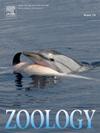Thermal energetics of bats of the family Vespertilionidae: An evolutionary approach
IF 1.6
3区 生物学
Q2 ZOOLOGY
引用次数: 0
Abstract
Thermal energetics define the way animals spend energy for thermoregulation. In this regard, numerous studies have determined that body mass (Mb) is the most influential morphological trait affecting the thermal traits in different species of birds and mammals. However, most of the studies have been focused on the basal metabolic rate (BMR), while other thermal traits have been less studied. We addressed this gap by examining thermal variables on bats of the family Vespertilionidae. Using open-flow respirometry, we measured BMR, absolute thermal conductance (C’), lower and upper critical temperatures (TLC and TUC), and breadth of the thermoneutral zone (TNZb) of 16 bat species ranging in Mb from ∼ 4.0–21.0 g from central Mexico. We: 1) combined our empirical data with information gathered from the literature and conducted phylogenetic analyses to investigate the relationship between Mb and thermal traits, 2) tested the relationship between mass independent C’ and mass independent BMR with TLC and TUC of bats, and the relationship between critical temperatures and TNZb, and 3) mapped the thermal energetic traits along the phylogeny to explore their evolutionary trends. We found a positive relationship between Mb and BMR and absolute C’ but not to TLC, TUC and TNZb of bats. Mass independent BMR and mass independent C’ were positively related to TLC and TUC. Finally, TLC showed a negative relationship with TNZb while TUC exhibited a positive relationship with this thermal trait. The phylogenetic approach indicates that over the evolutionary history, BMR and C´ have decreased while TLC, TUC and TNZb have increased. Our results suggest that: 1) differences in the limits of the TNZ and C’ may have helped bats to avoid the constraints on heat dissipation imposed by ambient temperatures, and 2) adaptive changes in Mb and thermal traits may have influenced the geographical distribution and energy-saving strategies of bats. These findings contribute to an understanding of how small endotherms cope with thermal challenges, shedding light on the physiological and evolutionary mechanisms that shape species’ ecological niches and biogeographic patterns across diverse environments.
蝙蝠科热能量学:一种进化方法
热力学定义了动物为调节体温而消耗能量的方式。在这方面,许多研究已经确定,体重(Mb)是影响不同种类鸟类和哺乳动物热性状的最具影响力的形态学性状。然而,大多数研究都集中在基础代谢率(BMR)上,而其他热性状的研究较少。我们通过研究蝙蝠科蝙蝠的热变量来解决这一差距。利用开放流动呼吸法,我们测量了墨西哥中部16种蝙蝠的BMR、绝对热导率(C′)、下临界温度和上临界温度(TLC和TUC)以及热中性区宽度(TNZb),范围从Mb到4.0-21.0 g。我们将实验数据与文献资料相结合,进行系统发育分析,探讨Mb与热性状的关系;2)利用蝙蝠的TLC和TUC测试质量无关C′和质量无关BMR的关系,以及临界温度与TNZb的关系;3)绘制热能性状沿系统发育的图谱,探讨热能性状的进化趋势。我们发现蝙蝠的Mb与BMR和绝对C′呈正相关,而与TLC、TUC和TNZb无关。质量无关BMR和质量无关C′与TLC和TUC呈正相关。TLC与TNZb呈负相关,TUC与TNZb呈正相关。系统发育方法表明,在进化史上,BMR和C´ 降低,而TLC、TUC和TNZb增加。结果表明:1)TNZ和C '极限的差异可能有助于蝙蝠避开环境温度对散热的限制;2)Mb和热特性的适应性变化可能影响蝙蝠的地理分布和节能策略。这些发现有助于理解小型恒温动物如何应对热挑战,揭示在不同环境中形成物种生态位和生物地理模式的生理和进化机制。
本文章由计算机程序翻译,如有差异,请以英文原文为准。
求助全文
约1分钟内获得全文
求助全文
来源期刊

Zoology
生物-动物学
CiteScore
3.90
自引率
0.00%
发文量
37
审稿时长
70 days
期刊介绍:
Zoology is a journal devoted to experimental and comparative animal science. It presents a common forum for all scientists who take an explicitly organism oriented and integrative approach to the study of animal form, function, development and evolution.
The journal invites papers that take a comparative or experimental approach to behavior and neurobiology, functional morphology, evolution and development, ecological physiology, and cell biology. Due to the increasing realization that animals exist only within a partnership with symbionts, Zoology encourages submissions of papers focused on the analysis of holobionts or metaorganisms as associations of the macroscopic host in synergistic interdependence with numerous microbial and eukaryotic species.
The editors and the editorial board are committed to presenting science at its best. The editorial team is regularly adjusting editorial practice to the ever changing field of animal biology.
 求助内容:
求助内容: 应助结果提醒方式:
应助结果提醒方式:


